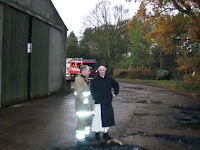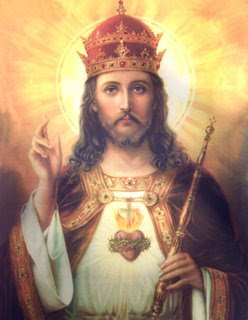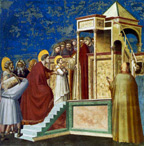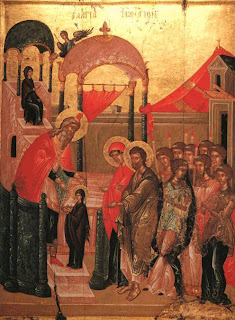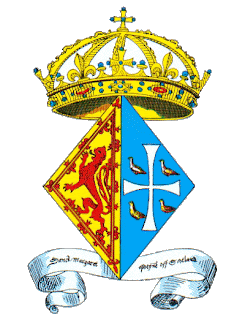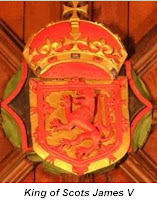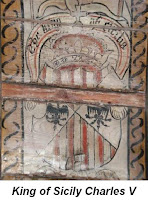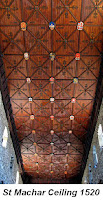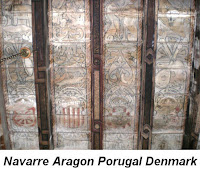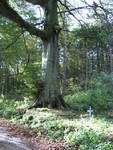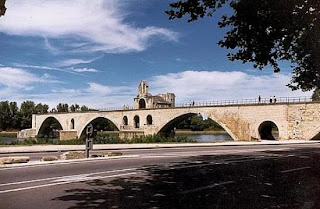
Holy Roman Emperor and the Kings of Christendom - Coats of Arms.
Heraldic Ceiling St Machar's Cathedral Aberdeen c. 1520
Heraldic Ceiling Nunraw House c.1607
In Nunraw “Past and Present”, the brief history by Fr. Michael Sherry, Nunraw 1946-2003, there is an account of the tempera ceiling painted about 1607. It has always been a subject  of interest to visitors. One guest, a young architect from Spain, was interested in the Heraldic Shield of his native Aragon. He found a similar shield in the Ceiling of St. Machar’s, Aberdeen. He thought the Nunraw version was the truer one. This gave us an excellent clue regarding the character of the Nunraw painted ceiling.
of interest to visitors. One guest, a young architect from Spain, was interested in the Heraldic Shield of his native Aragon. He found a similar shield in the Ceiling of St. Machar’s, Aberdeen. He thought the Nunraw version was the truer one. This gave us an excellent clue regarding the character of the Nunraw painted ceiling.
The following article is extracted from an excellent paper by Mgr. David McRoberts. This note focuses on the similarity of the Shields on the north side of the St Machar nave, the coats of arms of the Holy Roman Emperor and the Kings of Christendom, and the Nunraw ceiling. It throws so much more light on the understanding of the political, geographical and religious context of this faded work of art which has survived almost 400 years in Nunraw House.
Having discovered this much from two very different Scotiish painted ceilings, there is obviously much more to be learned from other examples such as those of Guthrie, Dunkeld or Dunfermline Foulis Easter and elsewhere.
Scottish Heraldic Ceilings
Taking one particular line of indirect evidence, we might consider the large number of painted ceilings which survive (usually in fragmentary condition) from the late sixteenth and early seventeenth centuries in the churches, palaces, castles and burgh house of Scotland. It would be absurd to imagine that this type of decoration was something which suddenly developed in Scotland in the late sixteenth century. It is only reasonable to assume that these painted ceilings were part of a long-established artistic tradition and, in fact, some surviving fragments of decoration at Guthrie, Dunfermline, Foulis Easter and elsewhere, make it quite clear that richly coloured ceilings were not unusual in medieval Scottish buildings. Some of these ceilings at Guthrie, Dunkeld or Dunfermline for example were painted with scriptural imagery; others we know were resplendent with heraldry. Only two medieval wooden ceilings survive in their entirety in Scottish churches. These two ceilings are both in Old Aberdeen - the ceiling of King's College Chapel and the ceiling of the nave of St Machar's Cathedral. The survival of the ceiling of St Machar's Cathedral is a happy accident for which we should all be grateful, for that ceiling is an extraordinary thing. In the true sense of the word it is quite unique; unique certainly in Scotland, unique in Great Britain, unique in Europe. It is not just a decorated ceiling; it is a vision of the political situation of Scotland and of Christendom at one particular moment in the early sixteenth century, expressed in that picturesque and precise short-hand of history that we call heraldry. - - -
Unusual in a Medieval Church 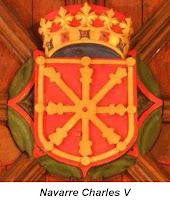
There are two features of the ceiling of St Machar's which strike one immediately. In the first place it is a flat ceiling. This, as far as we can judge, was unusual in a Scottish medieval church where wooden ceilings were normally given the shape of a barrel vault or of an ogival vault such as that of King's College Chapel. The coffered treatment of this flat ceiling is reminiscent of the splendid renaissance ceilings in the churches and basilicas of Rome and from that source possibly came one of the strands of artistic inspiration which went to the making of this ceiling.
The second feature of the ceiling is its scheme of decoration, and this is what makes it quite unique in Europe. The decoartion of a medieval church had a twofold purpose: to embellish the House of God and to instruct the faithful. Normally the church was decorated with scenes from the Holy Scriptures or from the legends of the saints, so that even the illiterate might gain some knowledge of the teaching of the Holy Scripture or of the virtues of the saints. The obvious duty of the Church was to impart instruction in spiritual things, but the medieval Church did not confine itself within these limitations
 The person who designed the ceiling of St. Machar's Cathedral set out to educate the citizens of Aberdeen, and the theme of his instruction was unusual in a medieval church. What he has in fact given us is a comprehensive, illustrated lecture on the contemporary politics of Christendom about the year 1520 - a lecture given with a strong bias in favour of the Scottish Nation. This lesson in politics is as easily understood by us in the twentieth century as it was by the sixteenth century Aberdonians. The ceiling gives a panoramic view of the European community of nations at one of the most critical and dramatic moments of its evolution. The months occupied in the construction of this ceiling, between 1519 and perhaps 1522, saw the climax of the Lutheran revolt in Germany which was to destory the traditional concept of Europe as a united spiritual and political entity. This ceiling records that traditional unity just at the moment when it was about to disappear forever. - - -
The person who designed the ceiling of St. Machar's Cathedral set out to educate the citizens of Aberdeen, and the theme of his instruction was unusual in a medieval church. What he has in fact given us is a comprehensive, illustrated lecture on the contemporary politics of Christendom about the year 1520 - a lecture given with a strong bias in favour of the Scottish Nation. This lesson in politics is as easily understood by us in the twentieth century as it was by the sixteenth century Aberdonians. The ceiling gives a panoramic view of the European community of nations at one of the most critical and dramatic moments of its evolution. The months occupied in the construction of this ceiling, between 1519 and perhaps 1522, saw the climax of the Lutheran revolt in Germany which was to destory the traditional concept of Europe as a united spiritual and political entity. This ceiling records that traditional unity just at the moment when it was about to disappear forever. - - -
Pope and Emperor
Here in this heraldic ceiling of St Machar’s then, we have an excellent example of how the churchmen and scholars of Aberdeen transmitted to the general public new political ideas which were developing on the European mainland. There is no place here for fanciful coats of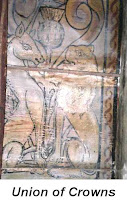 arms of Julius Caesar, or Juda Maccabeus, or Alexander the Great or Prester John. The ceiling depicts a real practical and everyday world and, because it depicts a real world situation, the Aberdeen ceiling betrays a strong interest in nationalist sentiment. This is simply a reflection of reality because the growth of nationalist sentiment and the emergence of independent nation-states was the really significant political development of the fifteenth and sixteenth centuries.
arms of Julius Caesar, or Juda Maccabeus, or Alexander the Great or Prester John. The ceiling depicts a real practical and everyday world and, because it depicts a real world situation, the Aberdeen ceiling betrays a strong interest in nationalist sentiment. This is simply a reflection of reality because the growth of nationalist sentiment and the emergence of independent nation-states was the really significant political development of the fifteenth and sixteenth centuries.
National rivalries had always been present in one form or another in medieval Christendom. The medieval ideal of the unity of Christendom visualised all Christian peoples of the west as united in one Holy Roman Empire where the supreme spiritual and political power was vested in Pope and Emperor as twin vicars of Christ, each exercising spiritual or political power in the name of God. This ideal never really materialised because Pope and Emperor never agreed on the limits of their separate authorities. Very often for good motives, and not infrequently for other motives, Pope and Emperor quarreled. - - -
Forty-eight shields, arranged in three series of sixteen coats of arms
These features become evident as one examines the coats of arms on the Cathedral ceiling. The general appearance of the 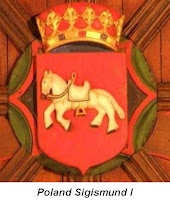 heraldic ceiling can be described quite simply. Its heraldic decoration consists of forty-eight shields, arranged in three series of sixteen coats of arms, running the length of the ceiling from east to west. As is fitting in a church, the principal series of coats of arms is that of the Holy Church and this row of shields occupies the central axis of the composition. The line of shields along the south side of the ceiling, which is heraldically the dexter or the more important side, depicts the coats of arms of the King of Scots and the nobility of Scotland. Along the north side of the nave, which is the heraldic sinister side, lesser in importance and dignity, we have the coats of arms of the Holy Roman Emperor and the
heraldic ceiling can be described quite simply. Its heraldic decoration consists of forty-eight shields, arranged in three series of sixteen coats of arms, running the length of the ceiling from east to west. As is fitting in a church, the principal series of coats of arms is that of the Holy Church and this row of shields occupies the central axis of the composition. The line of shields along the south side of the ceiling, which is heraldically the dexter or the more important side, depicts the coats of arms of the King of Scots and the nobility of Scotland. Along the north side of the nave, which is the heraldic sinister side, lesser in importance and dignity, we have the coats of arms of the Holy Roman Emperor and the  Kings of Christendom.
Kings of Christendom.
Basic to the whole scheme of decoration is the idea that the essential source of unity in Europe was the Christian Church. The Church is central to the whole concept of Christendom, so here it occupies the centre of the scheme of decoration. In spite of the German attacks made on the medieval Church which, in the year 1520 when the ceiling was being made, were reaching their climax, the papacy was still regarded as the supreme spiritual power in Christendom and accordingly the coat of arms of the Pope stands at the head of the ecclesiastical dignitaries. Above this shield is the traditional threefold crown of the papacy, the tiara, and behind the shield are the keys of gold and silver, representing the promise of Christ to Peter. “And I will give unto thee the keys of the Kingdom of heaven”. Medieval imagery had translated this promise into two real keys, one of gold, the other of silver; in Milton’s description of St Peter the symbolism of the two metals is made clear :
"Two massy keys he bore of metals twain, The golden opes, the iron shuts amain." - - -
Coats of arms - Emperor and Kings of Christendom
Of the two lines of shields, which run parallel to the central ecclesiastical series, that which runs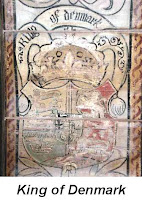 along the north side of the nave displays the coats of arms of the Emperor and the Kings of Christendom. At the date when our ceiling was being constructed, Christendom was in turmoil as medieval life was giving way to the modern world. The ceiling shows something of the relationship of Scotland with each of the other nations of Christendom at this crossroads of European history.
along the north side of the nave displays the coats of arms of the Emperor and the Kings of Christendom. At the date when our ceiling was being constructed, Christendom was in turmoil as medieval life was giving way to the modern world. The ceiling shows something of the relationship of Scotland with each of the other nations of Christendom at this crossroads of European history.
The dominant figure in early sixteenth-century European politics was the Holy Roman Emperor, the secular equivalent and often the rival of the papacy. The ceiling acknowledges the pre-eminence of the Emperor, whose coat of arms leads off the series of European potentates. The Emperor’s shield bears the double-headed eagle of the Holy Roman Empire. The shield is surmounted by the characteristic Byzantine crown and it is described by the caption : “Imperatorie Maiestatis” declaring that this is the coat of arms of “his Imperial Majesty”. This is the only place in the ceiling where the term "Majesty" occurs because at that time this title was reserved exclusively to the Emperor of the Holy Roman Empire. The person who wore the imperial crown at that particular time was the Emperor Charles V. The designer of our ceiling has very sensibly depicted the official coat of arms of the Emperor (the double-headed eagle) and not the personal coat of arms of Charles V. Charles V had acquired so many kingdoms, territories and titles by inheritance, by marriage, by conquest, that his personal coat of arms, with its multiplicity of quarterings and bearings, is the most complicated and elaborate in the whole range of European Heraldry. Charles V bestrode the European political scene like a veritable colossus. In addition to the imperial title, he is the owner of another three shields in this heraldic series of monarchs - Spain, Aragon and Sicily, so that altogether he occupies more than one quarter of this series of European kingdoms. When our ceiling was being constructed about 1520, Charles V who had inherited all the fearful problems of Europe and Spanish America, was as yet only twenty years of age. Over the next thirty-six years, he was to be engaged in almost continual warfare, against France, against the Turks, against the papacy, against the Protestant princes of Germany. One is not surprised that finally he abdicated in favour of his son and retired to a Spanish monastery to nurse his gout, mend his clocks and say his prayers.
bestrode the European political scene like a veritable colossus. In addition to the imperial title, he is the owner of another three shields in this heraldic series of monarchs - Spain, Aragon and Sicily, so that altogether he occupies more than one quarter of this series of European kingdoms. When our ceiling was being constructed about 1520, Charles V who had inherited all the fearful problems of Europe and Spanish America, was as yet only twenty years of age. Over the next thirty-six years, he was to be engaged in almost continual warfare, against France, against the Turks, against the papacy, against the Protestant princes of Germany. One is not surprised that finally he abdicated in favour of his son and retired to a Spanish monastery to nurse his gout, mend his clocks and say his prayers.
 The order in which the other monarchs of Christendom are arranged illustrates their various relationships with the Scottish nation. As Scotland’s traditional ally in Europe, the shield with the fleurs-de-lys of France is placed immediately after the Emperor. Next in turn comes the coat of arms of the King of Spain - Leon and Castile, one of the hereditary domains of Charles V. Only in the fourth place comes the King of England, King Henry VIII, and the coat of arms assigned to him would have been regarded by that monarch as an insult. English Kings were accustomed to quarter the three English leopards with the fleurs-de-lys of France to assert their claim to the French crown. The designer of our ceiling shows scant sympathy for such English pretensions and
The order in which the other monarchs of Christendom are arranged illustrates their various relationships with the Scottish nation. As Scotland’s traditional ally in Europe, the shield with the fleurs-de-lys of France is placed immediately after the Emperor. Next in turn comes the coat of arms of the King of Spain - Leon and Castile, one of the hereditary domains of Charles V. Only in the fourth place comes the King of England, King Henry VIII, and the coat of arms assigned to him would have been regarded by that monarch as an insult. English Kings were accustomed to quarter the three English leopards with the fleurs-de-lys of France to assert their claim to the French crown. The designer of our ceiling shows scant sympathy for such English pretensions and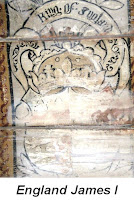 allows King Henry only the three English leopards. There follow the lesser kingdoms and dukedoms of Christendom and, in the last place, there is the delightful inclusion of the pot of lilies and
allows King Henry only the three English leopards. There follow the lesser kingdoms and dukedoms of Christendom and, in the last place, there is the delightful inclusion of the pot of lilies and
fret of salmon of the city of Old Aberdeen. This series of coats of arms outlines the full range of secular authority in Christendom from the Emperor of the Holy Roman Empire, through the kings and princes of Europe down to the town council of Old Aberdeen. It was a hierarchical arrangement of jurisdiction which medieval men would have fully understood and appreciated for the medieval world was an orderly society in which every institution had its correct and proper place. - - -
Bird’s-eye view of the political state of Christendom
The whole ceiling is a superb bird’s-eye view of the political state of Christendom and of the political aspirations of the Scottish nation in the years 1519 to 1521 when medieval values were giving place to the modern world and for the historian this ceiling is an authentic document of absorbing interest.
King of Scots
Apart from the fact that the series of coats of arms of the king and nobles of Scotland is given precedence over the Emperor and monarchs of Christendom, the feature of greatest interest here is the crown placed over the royal coat of arms of King James V. In the series of European monarchs on the north side of the ceiling, each royal coat of arms is surmounted by a simple open crown - a jewelled circlet of gold ornamented with fleurs-de-lys. This was the normal type of crown in medieval Europe and as used here it suggests that each and all of these monarchs are subject to the overall jurisdiction of the Holy Roman Emperor.
precedence over the Emperor and monarchs of Christendom, the feature of greatest interest here is the crown placed over the royal coat of arms of King James V. In the series of European monarchs on the north side of the ceiling, each royal coat of arms is surmounted by a simple open crown - a jewelled circlet of gold ornamented with fleurs-de-lys. This was the normal type of crown in medieval Europe and as used here it suggests that each and all of these monarchs are subject to the overall jurisdiction of the Holy Roman Emperor.
The crown assigned to the King of Scots however is of a different type. Here the royal coat of arms is surmounted by a jewelled circlet of gold, adorned with crosses and fleurs-de-lys, but it has also four arches rising form the circlet, enclosing the top of the crown and carrying an orb and cross over it. This was a new form of crown which was coming into fashion in Christendom. - - -
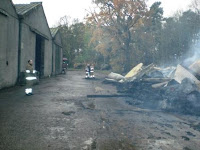
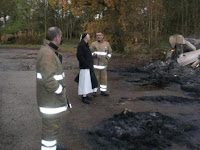

 After mid-night the large straw shed was burned down.
After mid-night the large straw shed was burned down.